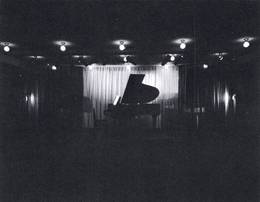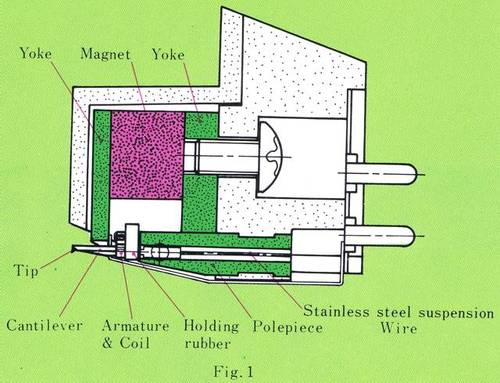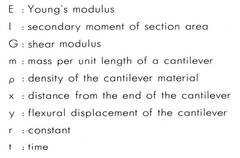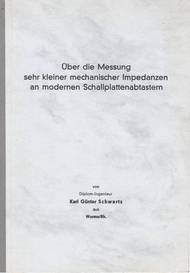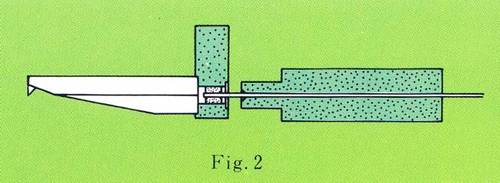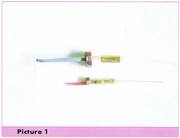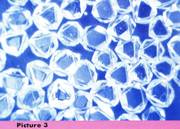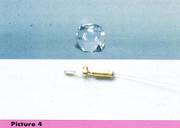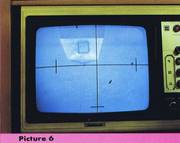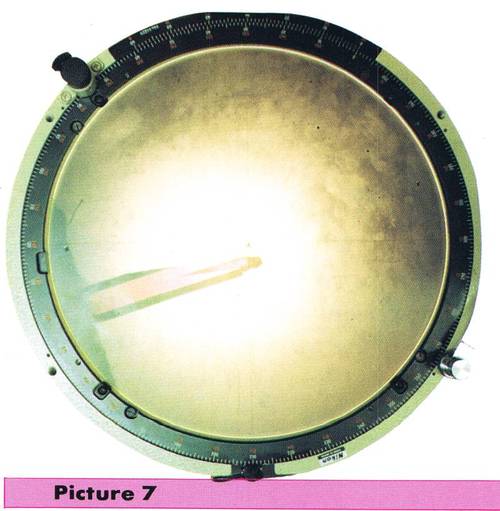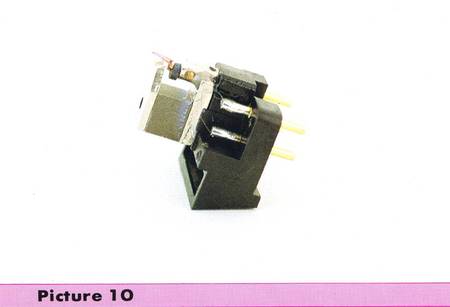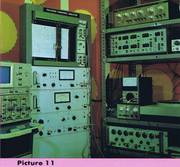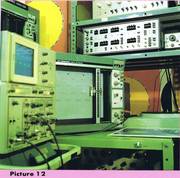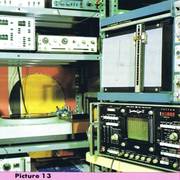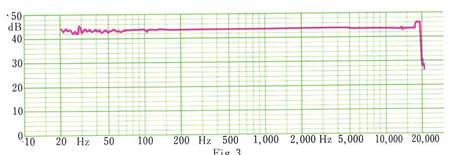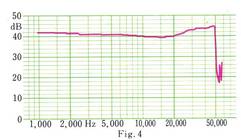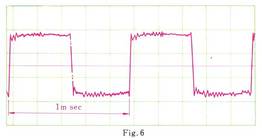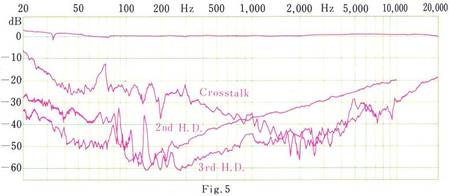Dieser Prospekt ist vermutlich auch aus 1979
Glänzte der vorige 4-seitige Prospekt noch in einem dunklen vornehmen Puff- rot, dem man von außen nicht ansah, worum es sich handelte, ist dieser zweite Prospekt schon aussagekräftiger.
Es geht also um so kleine Dinger, die der Fachmann sofort als Vinyl-Abtast-Systeme für Schallplatten erkennt. Und es muß etwas Wissenschaftliches dabei sein, denn auf der Frontseite sind ganz viele Formeln aus dem Physikunterricht der gymnasialen Oberstufe zu erkennen. Und dann ist die erste (Innen-) Seite erst mal völlig leer. Es fängt an mit der "General Description". Also es bleibt spannend, was da wohl drin steht.
.
General Description
Dynavector cartridges are now enjoying very good reputation and reviews in the world for their impeccable musicality in addition to the remarkable technical performance. The principle of the Dynavector products is that the music in the records should not only be reproduced with ultimate high fidelity but also with the excitement which the real musical performance contains.
Our designers and engineers are all real music lovers and know the real sound of music very well as well as the reproduced hi-fi sound from many top quality hi-fi equipments in the world. Our products must pass the hearing test as well as the strict technical measurements. The standard monitoring system in our company is the very huge and high efficiency loud speaker system as shown by the picture.
This (Anmerkung : Hifi-) system can deliver 125 dB sound pressure with only 100 watts from 5 HZ to 40 kHZ. (Anmerkung : vermutlich hocheffiziente amerikanische Klipsch-Hörner oder aber andere japanische Hornlautsprecher).
.
- Anmerkung : Auch auf dem scharzen dunklen Foto im Orignalprospekt kann man beim besten Willen keine Lautsprecher neben der Silhouette des oben offenen Flügels erkennen. Das Bild ist viel zu dunkel.
- Weiterhin muß man auch bei mittleren Englischkenntnissen öfter mal das Dictionary raus holen, um spezielle Attribute (z.B. impeccable) zu verstehen.
.
With this system we can identify the every detail in the performance of the equipment under test. After long testing experience of many products including our products, prototypes and other maker's products, we have noticed some puzzling problems in the evaluation of the cartridges. The frequency response of today's top quality cartridges whether they are moving magnet (MM) or moving coil (MC) is remarkably flat and wide range.
The philosophy of DV/KARAT
But actual sounds reproduced by these cartridges are not equal with each other. Even the transient response to the square wave seems to be independent with each other. These peculiarity is solved only by the concepts on which the design philosophy of DV/KARAT is based.
These purely theoretical investigations for the cartridge design concluded the unprecedent or unusual design criterion. This criterion needs the very short length and the very hard material in the cantilever (Anmerkung : Der Nadelträger) design. But this criterion was found to be absolutely the truth after we have listened to the reproduced sound by the prototypes of DV/KARAT. In all respects, the sound by DV/KARAT is outperforming the sound quality of the cartridges designed by the traditional design concepts.
On the CES CHICAGO in 1979 DV/KARAT was the winner
This innovative design concepts were recognized by the CES CHICAGO in 1979, and DV/KARAT was selected as the winner of the award of DESIGN AND ENGINEERING in this exhibition.
- Anmerkung : Stellen Sie sich vor, Sie und/oder Ihr Produkt sind auf einer der deutschen Funkausstellungen oder auf einer der sogenannten Hifi-High-End Messen "der Gewinner". Also erstens mal "der Gewinner" wovon oder von was und zweitens "der Gewiner" im Vergleich wozu. Die Marketing Abteilungen der jeweiligen Messegesellschaften hatten immer irgend "einen Gewinner" von "irgendetwas" ausgelobt und dann mordsmäßig laut in die gerade aktuellen Medien rausposount. Geblieben ist davon überhaupt nichts oder errinnern Sie sich an einen Gewinner von irgendetwas auf irgeneiner Funkausstellung aus Berlin ?
We were already given the same award from CES by our products in the past two years, that is, by DV/505 bi-axial and dynamically damped tone arm in 1977 and the DV/10X high output moving coil cartridge in 1978.
In addition to these honors, DV/KARAT will be given the honor as the pioneer of the new generation of the cartridges with the more advanced design concepts.
Theories behind the design of DV/KARAT/DIAMOND.
As partly described above, the today's top quality cartridges are designed to follow the criterion of the frequency response to be as flat as possible in the wide frequency range.
Not a few cartridges whether they are MM or MC have attained this criterion by their clever design. But the sound characters by these cartridges are embarassingly different with each other. By the conventional theory, the very flat frequency response with very wide bandwidth means no deformation or variation of the wave forms in output signals.
But there exists the evident difference in sound character from one cartridge to another. It is true and can be analysed theoretically that the performance of MM cartridge is virtually different from the one of MC cartridge because of an additional time constant in its characteristic equation of the transfer function, and this results in the difference of the sound quality between MM and MC cartridges. But it seems to be very puzzling to find that the high performance MC cartridges have their own sound character even though the technical data are quite similar with each other.
The material of rubber, cantilever and the stylus shape
These condition could be partly explained by the difference in damping rubber material, cantilever material and stylus shape. But they are not straight forward or fundamental. By facing these actual difficulty, the conventional design theory of cartridges is thought insufficient and too much optimistic for designing the top quality moving coil cartridges. In other words, more exact and precise design concepts are needed to settle these confusion.
About the design theories of today's cartridges
After many reviews of today's design theories for cartridges, we were required to reconsider the physical conditions of the cartridge from the more fundamental point of view. The most of design theories of today's cartridges are either the electro-mechanical simulation method or matrix algeblaic method which starts from the simpler vibration theory.
By the former method, the vibration system like a cantilever of a cartridge is considered as being comprised of many cascaded small segments like a ladder. Each segment is represented by the simple electro-mechanical analogy of resistance, capacitance and inductance which forms a simple electrical circuit.
Interconnecting these simple electrical circuits makes the complex network, the performance of which is similar to that of the actual michanical system.
This is the simulation method and this method is quite common to the electrical engineers. With this method, the detailed discussion relating to the frequency domain becomes easy. On the other hand, by the matrix method, the detailed consideration of the flexural modes of the bending vibration of a cantilever is possible.
Above two methods are effective to consider the steady state of the vibration of a cantilever, but no information of the wave propagation along the contilever is available by these approximation method. To avoid these difficulties, we have started from the next most rigorous vibration equation of a bending vibration of a cantilever in order to have more detailed aspects in this problem.
The mathematical calculation
Here :
.
E : Young's modulus
I : secondary moment of section area
G : shear modulus
m : mass per unit length of a cantilever
p : density of the cantilever material
x : distance from the end of the cantileve
y : flexural displacement of the cantilever
r : constant
t : time
.
From this equation, the propagating velocity Cb of "alpha" harmonic sinusoidal wave of the frequency f is calculated as following :
This is the most exact analytical solution for the wave propagation velocity taking into consideration of the rotary and shear effect in the bending cantilever. Even if these effects are ignored, the propagation velocity is calculated, as :
("lambda" ist the wavelength)
.
.
Anmerkung : < Das war also "der" Beweis >
Im Text folgt jetzt :
As shown by these analysis, the wave propagation velocity along a cantilever is obviously not constant but changes inversely as the wave length. A nonharmonic flexural pulsive signal may be regarded as consisting of a superposition of harmonic waves of different wavelengths.
.
- Anmerkung : Das ist der Text im roten Dynavector Original-Prospekt. Ich habe nichts dazu erfunden oder erdichtet. Wenn Sie jetzt ehrlich zu sich selbst sind, haben Sie weder die Voraussetzungen noch die Beweisführung noch die Analyse verstanden. - Ich auch nicht und ich habe über 9 Jahre an den Unis Technik studiert. Ich behaupte mal, 99% der Leser und Bewunderer des "Zauberers" haben (auch) nichts verstanden.
- Mit dem "Verstehen" solcher "Beweise" ist es sehr ähnlich zu der Doktorarbeit von Dr. Schwartz von der UNI Karlsruhe aus 1968, in der er den wirklichen Verschleiß von Nadelspitze und Rillenflanke mathematisch präzise über die dort auftretenden Reibungs- und Brems-Kräfte, also die sogenannte mechanische Impedanz, ausführlich hergeleitet hatte.
- Ich mußte diese 70 Seiten auch mindestens zweimal lesen und habe dann umgehend seine einleitenden Kapitel "neu gestaltet" und dann zum (endlich) besseren Verständnis deutlich umformuliert und vor allem, die Erklärungen von ganz hinten nach ganz vorne umgesetzt. Er hatte das sicher gut gemeint, aber diese Doktorarbeit ist bei den Herstellern wie Ortofon und ELAC nie "angekommen", weil die Entwickler es vermutlich auch nicht verstanden hatten. Die EMT Entwickler wußten dieses Wissen teilweise bereits vorher und haben ihre sogenannten "Tondosen" immer mit 3 bis 5 Pond spezifiziert.
.
The propagation velocity (Ausbreitungs-Geschwindigkeit)
Each of these waves has a different propagation velocity, so it follows that a flexural wave of arbitrary shape like in a musical wave form picked up from the record surface cannot propagate along a cantilever without DISPERSION, which results in a change of the wave shape in the output. A medium exhibiting a wave velocity Cb(lambda) depending on the wavelength is called a DISPERSIVE MEDIUM. The only flexural wave form propagating in a uniform cantilever without altering its shape is the simple harmonic wave.
As described as above, it is inevitable that the musical signal is deformed by its propagation along a cantilever as long as the transverse or bending motion is used for picking up the signal from records surface like in the today's phono cartridges. In the most cases today, the physical constant E/p which means the propagation velocity of the longitudinal wave in the medium is considered as the one of the measures for evaluation of the cantilever in a phono cartridge.
.
About bendings and vibrations
But this velocity has nothing do with the vibration of a cantilever, because the cantilever vibrates only in bending or transverse direction not in longitudinal.
As shown by (Formel 2) or (Formel 3), the propagation velocity can be improved by the larger constant of E which is the strength of cantilever material and the larger number of l/m which means that the profile of the section of the cantilever is the important factor. The fastest cantilever is considered to be the one having the large diameter and thin wall of the very hard and very light material.
When the very light cantilever of smaller diameter is used in the design attempting to have the very small equivalent mass by which the resonant frequency can be very high, the propagation velocity is not so much improved even by the very light and hard material used.
Unfortunately the most of the up-to-date high quality cartridges are designed by the criterion of the very wide frequency response with very high resonance frequency.
The propagation problem
The propagation problem is not particularly accounted or rather overlooked in their design. By these design the great number of frequency components contained in the pulsive signals disperse easily after travelling along a cantilever making the original pulsive wave form rather mild wave form losing some sharpness existing in the original sound. With these cartridges, we can hear the exessively smooth music from records, which seems to be very favourable sound.
Yes, many audiophiles love these character of the reproduced sound, but we can never approve such sound character by our standard as the real music listener. In other words, the most important factor in the music, that is, the excitement of the real musical performance is more or less lost in these design. As long as we use the today's principle of the cantilever in the cartridge design, the most drastic concept to improve the propagation problem is the use of the far shorter cantilever by the very hard material.
Treamandous and surprising results (die Theorie)
We had experiments by designing the moving coil cartridge with the diamond cantilever of only 2.5mm length.
.
.
The results were really treamandous and surprising. Every detail of the music in the record was more precise and had more liveliness and excitement as in the real music. Every instrument came closer to the listener out of the speaker boxes and they were positioned in the correct place.
In addition to these outstanding features, the sound from the old timer records which are stocked in the library as the nuisance was found to be astonishingly fresh and exciting when reproduced by this prototype.
As mentioned above, DV/KARAT is just the answer of us to fulfill the most difficult desire which almost all cartridges could not satisfy yet although their technical specification looks very excellent.
.
The resonance frequency is exceeding 50 KHz
By virtue of the unusually small size of DV/KARAT, the resonance frequency became very high exceeding 50 KHz, thus no damping action is needed within the frequency range from 20-50,000 Hz. The physical characteristics of rubber as the damping material are very complex, sometimes very embarrassing, to give the serious effects on the technical performance of the cartridge as well as on the musicality of that cartridge.
The rubber material
The damping coefficient of the rubber is regarded theoretically or practically not constant but affected more or less by the variation of the amplitude and the frequency of the signal. If the frequency response of the cartridge is flattned only by the excessive use of the rubber material, the sound quality of these cartridges is controlled by the characteristics of the rubber.
In addition to these unfavourable character, the performance of damping rubber is seriously affected by the temperature. The most cartridges change their sound quality and tracking ability by the change of room temperature. On the contrary, in the structure of DV/KARAT the rubber material is used only for the suspension of a cantilever to avoid its upward leaning when playing records.
This is not for the damping action, therefore, the sound quality and the tracking ability are almost not dependent upon the room temperature whether it is very cold or warm. The creeping time effect of the change of the rubber characteristics is also negligible.
Sie haben das also alles verstanden ?
You understand now why the philosophy and the construction of DV/KARAT are so different but outperforming other traditional cartridges. Almost all old masterworks on discs by B.Walter, M.Callas, J.Heifetz, V.Horowitz, A.Rubinstein, L.Klauss, etc., etc., presumably sleeping in your library can revive and sound again with similar excitement and high fidelity like the modern direct cut records, sometimes with more natural ambience than today's hi-fi records.
DV/KARAT guarantees you to extend your enjoyment by record music to the extent of hearing the live musical performance.
Anmerkung :
Im letzten Satz steht es dann ganz deutlich und klar, die Eigenschaften des KARAT kommen vor allem bei ganz alten (damals noch Mono-) Platten zum Tragen, so sagt es der Entwickler. Denn die ganzen physikalischen Nebenwirkungen eines sehr kurzen Röhrchens (also des Nadelträgers) werden nicht mal tangiert.
Auch kommt der Verdacht auf, daß die KARAT Systeme die schrillen Härten von Hornlaut- sprechern ausgleichen - also weich machen - könnten. - Über die eigentliche Abhöranlage seiner Musik-Spezialisten (die das angeblich alles bewertet hatten) - sagt er auch nichts. Da käme nämlich noch viel mehr Wahrheit ans Licht. In der schweizer Zeitung "Hifi-Szene" werden die ganzen Argumente fundiert "zerlegt" (besser gesagt, "zu den Akten gelegt").
.
Bis hierher geht es also nur um Musik-Geschmack und der ist absolut individuell. Wirkliche Experten (die Tonmeister und oft auch die Toningenieure) vergleichen in ganz speziell eingerichteten Studios bzw. Abhörräumen die Masterbänder mit den davon produzierten Schallplatten. Und manchmal kommt da eine echt Katastrohe raus. . In dem Fortsetzungsartikel stehen dann die Feinheiten. .Und hier wird noch mehr aus der Schule geplaudert.
.
.
Production of DV/KARAT/DIAMOND
Because the size of DV/KARAT is very small and the material of the cantilever (der Nadelträger) is also unusual, every common knowledge for manufacturing conventioal cartridge becomes useless.
We have decided before going into production of DV/KARAT to make the most use of the very advanced precision technology of NAMIKI PRECISION JEWEL Co. by the special agreement. The stylus in DV/KARAT has the line contact shape of 0,1 x 0,1mm size - illustrated in Picture 2.
Die zugehörigen Bilder 3, 4 und 5 sind weiter oben :
.
- These styli are polished from the natural octahedron diamond grains as shown by Picture 3.
- Diamond cantilever polished into the shape from the natural diamond shown by Picture 4.
- Ruby cantilever is also cut from the artificially grown single crystal of ruby and polished as shown by Picture 5.
To avoid the dropping out of the stylus from the cantilever, a very small hole must be drilled to fit the stylus in it, but this drilling was long time wanted without success, but NAMIKI succeeded finally by the use of the YAG laser beam machining process.
.
Der Laser brennt ..... a very small square hole
The laser beam machines (brennt) the very small square hole of 0,1 x 0,1mm size at the cantilever top (in die Nadelträger-Spitze) as shown by the ITV Picture 6.
- Anmerkung : Mit einem Eximer-Laser können sie Strukturen von 1µm brennen. Also ein Quadrat von 100 x 100µm ist kein Wunderwerk. Warum das quadratisch sein muß, während alle anderen Hersteller es rund bohren oder lasern, bleibt ein Fimengeheimnis.
- Für unsere aussagekräftigen mikroskopischen Bilder der diversen Abtastspitzen hätten wir von unserer SONY Alpha 5000 gerne dieses 100µm Quadrat über das HDMI-Kabel formatfüllend auf dem 24" HDMI Monitor.
Picture 7. shows the cantilever (den Nadelträger) with the stylus (dem "tip") mounted. The armature for the moving coil has very small size of 1x1mm and the thickness is 0,5mm.
.
- Anmerkung : Das ist eines der unkommentierten Fotos mit NULL Aussage.
.
Entscheiden Sie selbst, was Sie auf dem Bild 7 wirklich sehen
.
As shown in Fig. 2 (weiter oben), the suspension device of this very small armature needs a extremely precision machining process. This process is only possible by the electric discharge machine shown by Picture 8.
After assembling the entire cantilever, the very thin wires are wound 40 turns per channel automatically by the special winding machine as shown by Picture 9.
You can recognize how smail size is used in DV/KARAT compared to the ordinary moving coils by seeing Picture 1. The diameter of this wire is 11 micron meter and its material is silver.
The magnetic circuit is comprising the very strong rare earth magnet of light weight.
The body shell is made from the fibre grass reinforced polyester which has light mass but metalic hardness to ensure the better sound quality.
Picture 10 shows the assembled inside of DV/KARAT.
The small size as well as the light material resulted in total weight of 5.3gms/ which is affordable to match with the most modern low mass tone arms.
.
Das Ergebnis
.
Testing DV/KARAT
We believe that the final testing measure should be by the indivisual hearing test, and the technical data obtained by the today's standard method is not paticularly thoroughly related to the result of this hearing test.
But each piece of DV/KARATs is examined strictly by all the testing methods before delivery. This guarantees the quality and is regarded as the one condition to evaluate its performance. These test methods include frequency response, cross talk, second and third harmonic distortion, step response, tracking ability and intermodulation testing.
Frequency response
As a standard, we use B & K 1009 testing record for testing the frequency response from 20 to 20,000 Hz and this data sheet is attached to each cartridge before delivery. In addition to this record, we use JVC TRS 1005 record for the frequency response from 1,000 to 50,000 Hz.
.
- Anmerkung : Nach der glaubwürdigen Aussage von Vinyl-Platten Spezialist Brüggemann vom Schneidstudio Brüggemann in Frankfurt im Jahr 2013 waren seine selbst erstellten Testplatten nach 20 mal Abspielen völlig untauglich für irgendwelche seriösen qualitativen Tests oder Prüfungen. Und dort hatte er nur 15 und 18kHz Sinusfrequenzen drauf.
.
Distortion and cross talk testing
Distortion and cross talk characteristics are measured automatically with the harmonic tracking analyser and X-Y plotter. Fig. 3 is the typical frequency response of DV/KARAT from 20 to 20,000 Hz, and Fig. 4 is the one from 1,000 Hz to 50,000 Hz. Fig. 5 shows the cross talk and harmonic distortion characteristics of DV/KARAT.
Picture 1 1 shows these instrumentation.
.
Step response (bei uns die "Sprungantwort")
If the dynamic characteristics of a cantilever is regarded as non dispersive medium, the step response and the frequency response have the correspondence of one to one. In DV/KARAT this dispersion is kept minimum, so the square wave response at 1,000 Hz of Fig. 6 could be a good measure for the frequency response.
By seeing this picture, you can recognize that the "square waves" recorded by the cutter head having the resonance at about 35,000 Hz are clearly reproduced with excellent details.
.
- Anmerkung : Das mit den "square waves" ist leider absoluter Unsinn ! Keine Schneidmaschine bzw. kein Schneidkopf kann Rechtecksignale (Die Bezeichnung "Square Waves" ist grundsätzlich falsch) schneiden !!! Es gibt nämlich keine Rechteck-"Wellen". Es gäbe nur Rechtecksignale. Doch auch die kann kein mechanisches System als Rille ritzen bzw. schneiden oder überhaupt realisieren. Auf der Platte sind - wenn überhaupt - Dreiecksignale geschnitten.
.
There is no overshoot nor undershoot but only transients by the cutting head is observed in this picture with excellent repeatability. To record the square wave response, firstly the output voltage is memorized in the wave memory equipment of very fast response, then the memorized wave form is delivered to XY plotter very slowly but with very good precision. Picture 12 shows these instruments. In this case, the testing record is CBS STR 112.
Intermodulation distortion measurement
CBS STR 112 testing record is used to measure the intermodulation distortion. The output voltage of the cartridge playing CBS STR 112 is fed to the real time spectrum analyser which is shown in Picture 13.
The spectrum diagram on the screen of this instrument is hard-copied on the paper to make the calculation of the intermodulation distortion figure.
Fig.7, a, b, c, d, e show the typical spectrum when 400 Hz plus 4,000 Hz are applied in the lateral direction to DV/KARAT in 6, 9, 12, 15, 18 dB excess state of 400 Hz component which is added on the constant 4000 Hz component.
By this figures, the intermodulation figure of DV/KARAT is -30 bB at 6 dB, -27 dB at 9 dB, -23 dB at 1 2 dB, -20 dB at 1 5 dB and -16 dB at 18 dB. This intermodulation figure seems to be far better than almost all other cartridges whether they are MC or MM.
.
Conclusion
As obviously as described above, the DV/KARAT/ DIAMOND is the products of innovative thinking. It is entirely the new generation of phono cartridges. Every detail which was missed by the traditional cartridges is now recovered with astonishing precision.
Your old stock of records of early 1960 or end of 1950 revives with refreshing musicality and high fidelity. By DV/KARAT, all records with no exception sound their best, making it useless for you to care about the recording condition before buying. Then you will find all records since 1960 are more or less hi-fi recording and some of them can outperform today's direct cut records.
DV/KARAT widens your choice of music in record, and revives a lot of famous master works with the perfection being thought impossible before. You are wholly rewarded by DV/ KARAT and no further worry about cartridges is needed. Only one thing is "listen to music with perfect satisfaction". The best results are available by the use of our DV/505 tone arm and DV/6A or DV/6X stepping up transformer.
.
Die letzten beiden Seiten sind auch leer ....... !
So bleiben von den insgesamt 12 Seiten der knall-roten Broschüre nur 8 (acht !) - mit Informationen bedruckte - Seiten übrig und dort fehlen glaubwürdige Aussagen über Physik und Technik. Alleine die These, ein kurzer Nadelträger löse die Abtast-Probleme der analogen Schallplatte, das ist leider hahnebüchner Unsinn.
Entweder muß der Nadelträger exakt von der Länge her dem des (damals beim Schneiden der Folie benutzten) Schneidstichels gleichen oder sogar länger sein und damit wäre er deutlich schwerer. Bei Stereoplatten führt die Nadelspitze sogar dreidimensionale Bewegungen aus, die dafür verantwortlich sind, daß fast die gesamte kleine Fläche der Nadelverrundung mit den unterschiedlichsten Schliff-Flächen mit der Rille Kontakt hat.
Darauf wird mit keinem Wort eingegangen und je kürzer der Nadelträger ist, desto größer ist der Auslenkungswinkel in der Gummi-/Silikon- Lagerung gegenüber einem längeren Nadelträger.
Aus diesem Gesichtspunkt ist der Prospeket absolut mangelhaft und hat insgesamt "null" Aussage. Es ist - physikalisch gesehen - reines populistisches "Marketing Gewäsch" für unbedarfte Opfer.
.
Hier noch einmal der Verweis auf die beiden kritischen Artikel aus einer Zeitschrift aus der Schweiz
.


